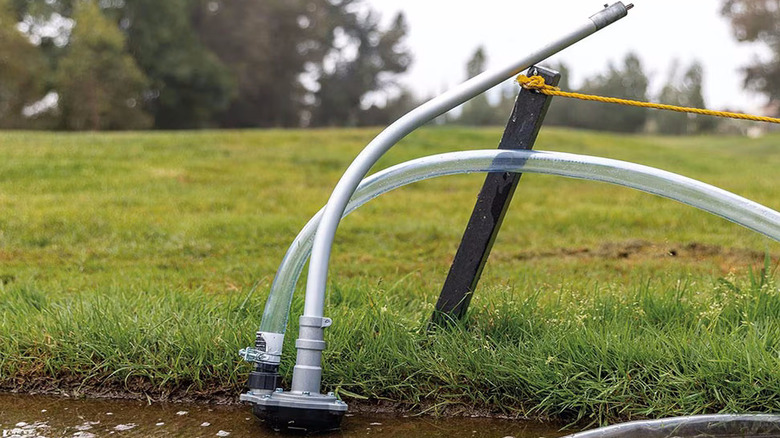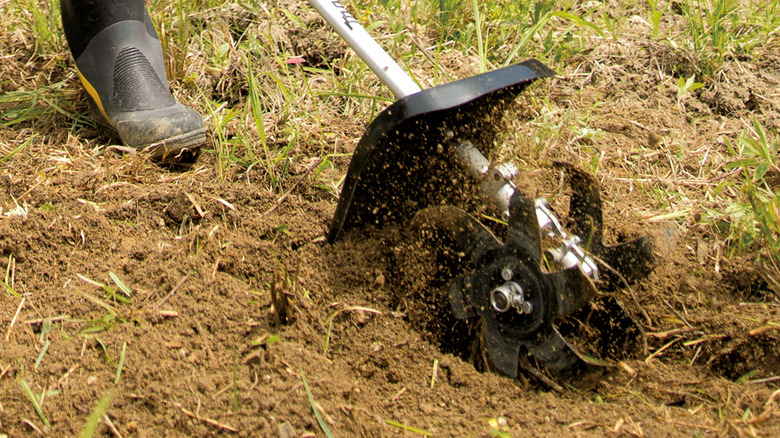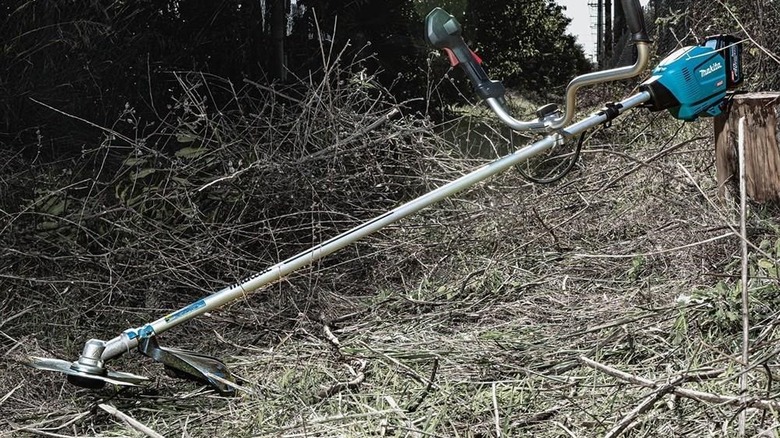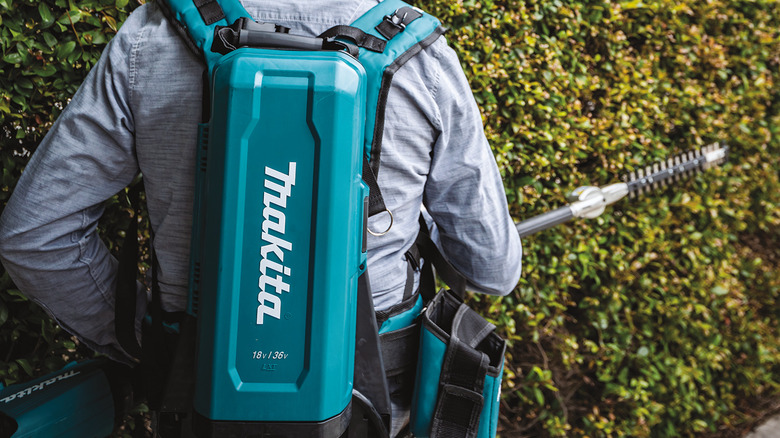5 Underrated Makita Cordless Weed Eaters And Accessories
We may receive a commission on purchases made from links.
Let's be honest: We all love the results of our string trimmers more than the machines themselves. They're uncomfortable, messy, and can leave some operators vibrating for hours. Not to mention the bump-and-feed heads that work great until they seize up and cease to ever operate properly again. (There's a reason there are so many aftermarket trimmer heads available, after all. If only they were better than the originals.) But you can restore your love affair with string trimmers through more capabilities and more power.
Shaft-mounted attachments for string trimmer power heads are nothing new, but Makita executes them well. As long as you're careful to note any compatibility issues (brush cutters must be used on blade-capable string trimmers, for example), you can parlay your machine into a full suite of lawn maintenance tools, from pole saws to water pumps. A lot of this relies on Makita's couple shaft attachment system. The brand's cordless outdoor power equipment line also has a few tricks up its sleeve to make all this more valuable and more powerful, from gasoline engines to big battery banks. Yes, they're more expensive than budget battery-powered weed eaters, but there's also a lot more to them.
Water Pump Couple Shaft Attachment
The need for a reliable transfer pump often surprises homeowners who suddenly need to deal with flooding, irrigation, and other wet stuff. If you're already in on the Makita couple shaft ecosystem, the $199 Makita Water Pump Couple Shaft Attachment might be a good option for you. In addition to the obvious benefit of taking advantage of the brand's battery platforms via a detachable power head, this pump has a lot going for it.
The model moves 39 gallons per minute (2,340 per hour) and 677 gallons on each charge of a 40V XGT 4.0 Ah battery. Makita says the pump has a maximum suction height of 49.2 feet — a very respectable figure for a design with a 1-inch outlet. Speaking of the 1-inch hose, while the Makita pump doesn't come outfitted with a standard 1-inch discharge coupling, it does have a barb attachment (to be used with a clamp) that's common enough on these hoses. The intake on the bottom of the pump (which includes a strainer) allows it to work in as little as 13/16 inches of water.
At 2.2 pounds without a hose, power head, or battery, the pump is reasonably light. Obviously, this is good since it's meant to be hand-operated by someone holding it. Oddly enough for a pump touted for clearing flood waters, it doesn't appear to be able to stand up on its own (despite the publicity shot above showing the model with the power head detached so it can stand up).
Cultivator Couple Shaft Attachment
If you've spent more than a few moments doing the backbreaking work of working garden soil, the thought of buying a tiller has occurred to you. You're probably going to call this thing a tiller attachment, but it's important to understand how this Makita Cultivator Couple Shaft Attachment is different. The functions of a tiller and cultivator are similar, but the former has more heft and power and can dig deeper. It excels at breaking up hard soil, while a smaller cultivator is great at getting into the rows and corners that its counterpart can't typically reach. The attachment has six 9-inch tines explicitly for "rejuvenation" of already-planted soil, not for breaking new ground. Its 6.65-pound weight is a boon to a tired operator, but it's not all that helpful in digging deep.
But here's the thing: Those four-stroke, gas-powered walk-behind machines we all think of as tillers aren't generally considered tillers, either — they're also usually described as cultivators. While this Makita device will almost certainly just bounce off of hard or rocky soil, in almost any other circumstance, you will be glad you have it. And your back is telling you that the $279 price tag isn't bad.
9-inch, 3-tooth brush cutter blade
A string trimmer is nice and all, but if you venture far from the herbaceous jungle of suburban flower beds, you'll need something sturdier. The Makita 195298-3 brush-cutter blade might be just the tool for you, depending on which string trimmer you have. The tri-blade cutter is compatible with any blade-capable Makita model, including the Makita 36V LXT Brushless String Trimmer and the MM4 4-Stroke Engine Couple Shaft Power Head after installing the Brush Cutter Conversion Kit.
Makita says the blade is capable of cutting "grasses, shrubs, underwood, and thicket," which covers a lot of ground. If you've ever stood in your yard chipping away at a sapling with trimmer string, you understand the appeal of this ominous-looking attachment. (Makita does offer two other designs, with four and 24 teeth.) And note that the blade is reversible, so you can get more out of it and reduce the amount of time spent cleaning and sharpening.
25.4 cc MM4 4‑Stroke Engine Couple Shaft Power Head
You might have noticed that the performance of couple shaft accessories like the water pump and cultivator — and the ability to use the brush cutter at all — relies on the strength of the string trimmer power head. Makita's 40V XGT and 36V two-battery LXT string trimmers are great, but when you really need to pour on the power, you can't do better than a four-stroke gasoline engine. So the company offers a version of its couple shaft power head with exactly that — the 25.4 cc MM4® 4‑Stroke Engine Couple Shaft Power Head.
Multiple versions of the common string trimmer form factor tools — pole saw, brush cutter, edger, and a variety of hedge trimmers — have an integrated four-stroke gas engine. But the MM4 power head allows you to use couple shaft accessories with one model rather than buying a separate engine, etc., for every tool. This is great for homeowners who might not be deploying a landscaping crew and can make do with just one machine at a time. The beauty of the lightweight four-stroke engine is that you don't have to mix oil and gas, which at best gives you an additional can to deal with and at worst blows up your engine when you mix it wrong. The engine layout is well-thought-out for maintenance tasks like adding oil, adding gas, and changing the air filter. And at 10 pounds, it's not an outrageously heavy thing to lug around for a few hours.
Makita backpack power supplies
String trimmers with gas engines are the traditional answer to the need for more runtime, a common disadvantage of battery-powered weed eaters. Of course, maybe you don't want to carry, shout over, and breathe the fumes of a gasoline engine at all, but a standard lithium battery doesn't hold up to the demands of your yard. Consider, then, the Makita ConnectX 1,200Wh Portable Backpack Power Supply. Now look at the price ($1484.44) and reconsider. This power pack is obviously targeted at commercial landscapers, and the average homeowner will understandably balk at the idea of paying almost $1,500 for a big battery.
Another option is the PDC01 ConnectX, LXT, LXT X2 and XGT Portable Backpack Power Supply. At $599, it has many of the advantages of its $1500 big brother: increased runtime, broad compatibility with Makita cordless products, IPX4 weather resistance, and more. This model uses four standard tool batteries, which aren't included (Makita probably assumes you got these with the tools), and can operate Makita's 36V LXT X2 tools, which make use of two 18V LXT batteries at the same time. Like the 1,200-watt backpack, the PDC01's harness can be detached, leaving the battery pack as a freestanding power supply. LED indicators show the charge levels of the individual lights, and compatibility with 18V and XGT tools is achieved with an adapter that is sold separately. Note that the Amazon listing doesn't mention XGT tools at all, but Makita says the backpack is compatible, assuming you buy the adapter.





